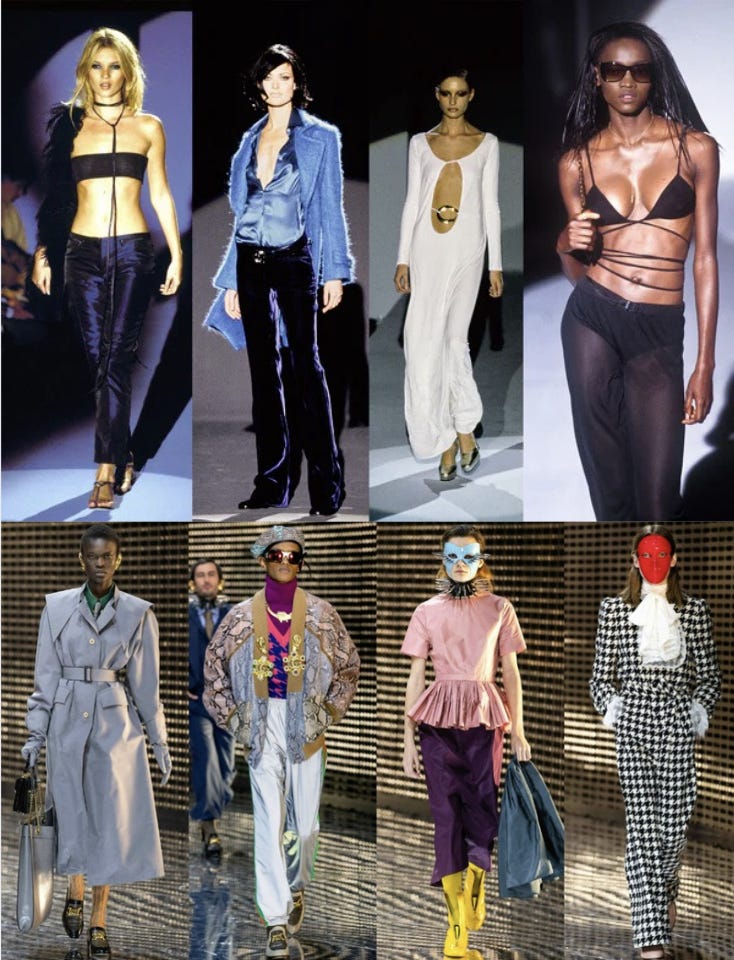Fashion is caught in a time loop. From Y2K to the ever-recurring '80s resurgence, the industry has mastered the art of nostalgia-driven reinvention. But in this constant cycle of revisiting the past, we have to ask: Is fashion running out of original ideas? Or are we just in search of what we believe to be a better time?
Samantha Hermans explores how social media, consumer psychology, and corporate decision-making have shaped fashion’s obsession with the past. But amidst the endless reboots and re-releases, we also spotlight the designers daring to break the cycle.
At Fashion Talk, we believe in honoring the past while defining the future. Let’s dive into the nostalgia economy and ask ourselves: Are we celebrating history, or are we stuck in it?
Happy reading,
Amarissa
It began with Y2K, then we were transported back to the 90s, and next the 80s resurged—each decade resurfacing as if plucked from a time capsule unearthed by designers in need of a new collection. In recent years, nostalgia has become a dominant driver of consumerism. An unending, reminiscent cycle feeds our longing for eras that we never lived through, shaping the purchasing habits and styles of future generations. In a time when most brands use reference pictures of past collections to create their ‘newest’ ideas, has fashion truly exhausted its capacity for originality? Have we completely run out of innovative fashion? If so, what can brands do to create rather than simply recreate?
Scroll, Remix, Repeat: How Social Media Fuels the Nostalgia Economy
Social media has made nostalgia more accessible to everyone, whether it’s in fashion, movies, or media. Everything is presented to us as a copy of something from the past. Songs are sampled and remixed, movies are all sequels or remakes, and fashion brands rework their iconic styles until the runway lights go out. I can understand every reference that a ’90s baby makes, despite being born in 2002. During the age of cutting-edge innovation and technological advancements, when it comes to pop culture, everyone just wants to stare into the past at “the good old days.”
The Psychology of Nostalgia Consumption
At its core, nostalgia is a longing for something that no longer exists. This feeling arises when we experience negative emotions such as boredom, anxiety, or loneliness, which drives us to seek comfort in the familiar. Whether it’s through music, movies, or clothes, these psychological pulls drive us to look for pieces of that “better” era. We explore these emotions through consumerism, feeling compelled to purchase something new to connect to the past.
Nostalgia strikes during times of social isolation, seen explicitly in the resurgence of Y2K that resurfaced during the not-so-good days of 2020. After years and years of claiming that the devil in denim was low-rise jeans, it only took a couple of weeks of social distancing until they became the newest fad. In times of crisis, nostalgia sells!

An article by Vox presents research that most people associate their present-day life as being worse off than it was a few years ago, despite statistics showing that quality of life has improved overall. Humans experience selective memory when recalling the past, glorifying certain eras while forgetting their flaws. This loss-aversion in memory can make everyone believe that reality today is somehow less valuable than that of the past.
Somewhere along the way, maybe it was after the second Ghostbusters remake, large corporations realized that reviving nostalgia was an easy way to package familiarity. Why pay for groundbreaking new ideas when you can re-release what worked when Gisele Bündchen first wore it?
From Community to Commodity
Fashion and art have always been rooted in community. Collections become a reflection of a brand story and identity, strung together by the team of people who created and invested in them. As corporate heads increasingly turn their attention to profit and expediency, it feels like community has been left behind.
Today, creative directors are tossed from brand to brand in search of the highest price tag. Gone are the heydays of Karl Lagerfeld for Chanel or Tom Ford for Gucci, where a singular vision defined a brand.

The desire for authenticity is why so many consumers are drawn to vintage designs. Buying into nostalgia feels like reclaiming a time when quality and creativity mattered more than shareholder profits. Maybe we want to feel like a part of the generations who came before us, who experienced a life of newness that we yearn for today. Are we romanticizing the past, or is modern fashion truly losing its soul?
Reduce, Reuse, Recycle: The Fashion Machine
The reality of mass-produced luxury fashion is a relentless, fast-paced schedule, with design teams juggling multiple collections at a time. Most brands use reference pictures from past collections or even competitors' work, making innovation increasingly difficult.
With companies and designers forced to churn out an entirely new and novel collection every three months, newness becomes a burdensome task. What’s more concerning is how we’ve normalized this relentless cycle, while Zara can effortlessly replicate a one-of-a-kind runway piece and sell it for $29.99 the following week.
Fast fashion brands have been called out for their lack of originality and tremendous environmental concerns, but the issue runs deeper. If heritage brands—built on talent, craftsmanship, and innovation—can have their designs copied and sold at a fraction of the price, what justifies the luxury price tag?
Iconic Looks Overload: Algorithm-Driven Trends
Social media plays a massive role in fashion’s nostalgia loop. Instagram and Pinterest's constant exposure to iconic past looks initially sparked my love for fashion in the first place, as it has for many aspiring designers and marketers. However, the endless churn of algorithms and “For You” pages creates a vortex that makes consumers feel they need the newest, coolest thing every two months. It dilutes the need for self-expression and personal style with a recommendation overload from strangers on the internet.
These platforms can make customers feel as though they need to revamp their wardrobe after every fashion week. Fashion cycles that once lasted decades are now compressed into fleeting microtrends, reducing their brilliance to a series of disposable moments.
We can all acknowledge the moment that was the green Jennifer Lopez Versace dress, but we can also see the irony in her and Versace’s outright refusal to let it rest. At what point does “paying homage” to the greats become a crutch, a way to mine the past for clickbait rather than creativity? Recreating a look or collection comes with a responsibility to emulate and respect the history behind it.
The Roaring (20)20s

The good news? Innovation isn’t dead! It’s just happening in smaller spaces. Emerging designers, unburdened by corporate pressures, are defining fashion’s future.
The three artists featured above are small designers who have gotten noticed at recent fashion weeks for their head-turning, innovative designs. It’s designers like them—unconstrained by mass-market demands—who will shape the trends of this decade. With a more niche audience, they have the freedom and flexibility to experiment, take creative risks, and push boundaries. The result? Thoughtfully crafted, original designs where artistry and innovation take center stage.
Major brands are locked in constant competition, leading to commercialization, high employee turnover, and ultimately, a creative drought. When it comes to trend searching and forecasting, looking solely to big brands and mass-market retailers will only bring you full circle—back to the same recycled ideas.
Honoring the Past, Defining the Future
Now more than ever, we crave community and connections while growing increasingly critical of the corporations controlling the supply chains behind the world's most prestigious brands. Disillusioned by fleeting microtrends, consumers are searching for meaning—seeking garments that carry value beyond their price tag. In a rapidly changing world, we cling to pieces from past generations, using fashion as a thread that ties us together when everything else feels like it’s pulling us apart.
The reality is…nostalgia isn’t going anywhere. Instead of letting the past dictate our style, we can take inspiration from it while forging our own path.
Shop small, shop smart, and shop YOU. Celebrate the history that brought us here, but don’t let it define you.
Contributing edits by our Winter ‘25 Student Writing Program editor, , with final oversight & edits by Amarissa.
Today’s writer…
Samantha is a participant in Fashion Talk's Winter 2025 Student Writing Program. Aligned with our mission to uplift emerging voices in the fashion industry, we’re excited to share her fresh and insightful perspective with our community.
Get to know her here!
connect with us: IG → pinterest → twitter → bluesky










I am so happy to have a space where I can share my critiques of the industry uninhibited, thank you to Amarissa and Hala for your guidance, you make this process fun!
I hope you all enjoy!
This was such a great read! It's so funny because I was just talking to a friend recently about how creative directors are being recycled by different brands and there isn't a lot of new happening. Instead, some reuse their successes found in other brands from the past to relaunch under a different name. You bring up a good point about the past being a crutch at times.